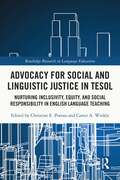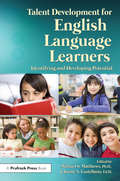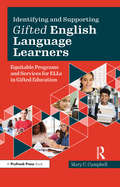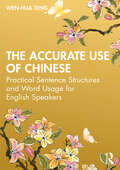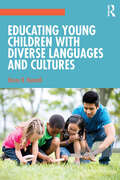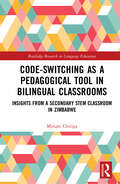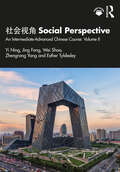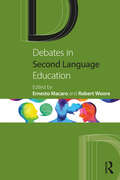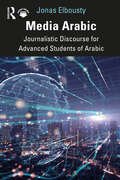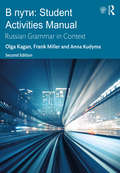- Table View
- List View
Advocacy for Social and Linguistic Justice in TESOL: Nurturing Inclusivity, Equity, and Social Responsibility in English Language Teaching (Routledge Research in Language Education)
by Christine E. Poteau Carter A. WinkleRecognizing the need for increased social justice in the fields of TESOL and English Language Teaching (ELT) globally, this volume presents a range of international case studies and empirical research to demonstrate how English language instruction can promote social and linguistic justice through advocacy-oriented pedagogies and curricula. Advocacy for Social and Linguistic Justice in TESOL adopts a critical, and evidence-based approach to identifying effective practice in ensuring inclusive and equitable learning and teaching. Chapters address emergent issues including heritage language and L1 attrition, teacher and learner identity, and linguistic colonialism, as well as wider issues such as global citizenship and human rights. Focus is placed on empowering both educators and learners as advocates of social justice and consideration is also given to how social responsibility can be supported through enhanced teacher preparation and professional development. Making a timely contribution at the intersection of advocacy, social justice, and English language teaching, this book will be key reading for postgraduate researchers, scholars, and academics in the fields of TESOL and ELT, as well as language education, applied linguistics, and the sociology of education more broadly. English language teachers and practitioners will also find this volume of interest.
Talent Development for English Language Learners: Identifying and Developing Potential
by Michael S. Matthews Jaime A. CastellanoTalent Development for English Language Learners offers concrete guidance to teachers, schools, and administrators seeking to maximize the potential of all of their students. Each chapter will focus thematically on an issue relevant to developing the talents and potential of gifted English language learners (ELLs) in inclusive educational settings. Examples of how schools or educators might conventionally conceptualize and handle the issues related to ELLs and what the concerns or unintended negative outcomes are for gifted ELLs are provided. The authors focus on what an “ideal” response might be from the lens of both the gifted education and the language education field, and how collaborative efforts across these perspectives yield effective interventions in schools and related educational settings for students who are both English language learners and highly academically able.
Identifying and Supporting Gifted English Language Learners: Equitable Programs and Services for ELLs in Gifted Education
by Mary Catharine CampbellThis book is a practical guide for identifying and supporting gifted English language learners (ELLs) based on research and firsthand teaching experience. This book:Presents practical information and strategies for identifying gifted ELLs.Helps readers understand more about potentially gifted behaviors and talents.Supports the enrichment and social-emotional needs of these students.Includes background information, teaching strategies, and methods.Offers ideas for lessons and activities that can be used to support any learner.Research from the last 2 decades shows that there is a considerable disparity between ELLs and native English speakers identified as gifted. This book will inspire action by key players in these students' lives, including English language and gifted educators, classroom teachers, school administrators, district and state leaders, families, and the greater community.
Identifying and Supporting Gifted English Language Learners: Equitable Programs and Services for ELLs in Gifted Education
by Mary Catharine CampbellThis book is a practical guide for identifying and supporting gifted English language learners (ELLs) based on research and firsthand teaching experience. This book:Presents practical information and strategies for identifying gifted ELLs.Helps readers understand more about potentially gifted behaviors and talents.Supports the enrichment and social-emotional needs of these students.Includes background information, teaching strategies, and methods.Offers ideas for lessons and activities that can be used to support any learner.Research from the last 2 decades shows that there is a considerable disparity between ELLs and native English speakers identified as gifted. This book will inspire action by key players in these students' lives, including English language and gifted educators, classroom teachers, school administrators, district and state leaders, families, and the greater community.
Talent Development for English Language Learners: Identifying and Developing Potential
by Michael S. Matthews Jaime A. CastellanoTalent Development for English Language Learners offers concrete guidance to teachers, schools, and administrators seeking to maximize the potential of all of their students. Each chapter will focus thematically on an issue relevant to developing the talents and potential of gifted English language learners (ELLs) in inclusive educational settings. Examples of how schools or educators might conventionally conceptualize and handle the issues related to ELLs and what the concerns or unintended negative outcomes are for gifted ELLs are provided. The authors focus on what an “ideal” response might be from the lens of both the gifted education and the language education field, and how collaborative efforts across these perspectives yield effective interventions in schools and related educational settings for students who are both English language learners and highly academically able.
The Turkic Languages (Routledge Language Family Series)
by Lars Johanson Éva Á. CsatóThe Turkic languages are spoken today in a vast geographical area stretching from southern Iran to the Arctic Ocean and from the Balkans to the great wall of China. There are currently 20 literary languages in the group, the most important among them being Turkish with over 70 million speakers; other major languages covered include Azeri, Bashkir, Chuvash, Gagauz, Karakalpak, Kazakh, Kirghiz, Noghay, Tatar, Turkmen, Uyghur, Uzbek, Yakut, Yellow Uyghur and languages of Iran and South Siberia. The Turkic Languages is a reference book which brings together detailed discussions of the historical development and specialized linguistic structures and features of the languages in the Turkic family. Seen from a linguistic typology point of view, Turkic languages are particularly interesting because of their astonishing morphosyntactic regularity, their vast geographical distribution, and their great stability over time. This volume builds upon a work which has already become a defining classic of Turkic language study. The present, thoroughly revised edition updates and augments those authoritative accounts and reflects recent and ongoing developments in the languages themselves, as well as our further enhanced understanding of the relations and patterns of influence between them. The result is the fruit of decades-long experience in the teaching of the Turkic languages, their philology and literature, and also of a wealth of new insights into the linguistic phenomena and cultural interactions defining their development and use, both historically and in the present day. Each chapter combines modern linguistic analysis with traditional historical linguistics; a uniform structure allows for easy typological comparison between the individual languages. Written by an international team of experts, The Turkic Languages will be invaluable to students and researchers within linguistics, Turcology, and Near Eastern and Oriental Studies.
The Turkic Languages (Routledge Language Family Series)
by Lars Johanson Éva Á. CsatóThe Turkic languages are spoken today in a vast geographical area stretching from southern Iran to the Arctic Ocean and from the Balkans to the great wall of China. There are currently 20 literary languages in the group, the most important among them being Turkish with over 70 million speakers; other major languages covered include Azeri, Bashkir, Chuvash, Gagauz, Karakalpak, Kazakh, Kirghiz, Noghay, Tatar, Turkmen, Uyghur, Uzbek, Yakut, Yellow Uyghur and languages of Iran and South Siberia. The Turkic Languages is a reference book which brings together detailed discussions of the historical development and specialized linguistic structures and features of the languages in the Turkic family. Seen from a linguistic typology point of view, Turkic languages are particularly interesting because of their astonishing morphosyntactic regularity, their vast geographical distribution, and their great stability over time. This volume builds upon a work which has already become a defining classic of Turkic language study. The present, thoroughly revised edition updates and augments those authoritative accounts and reflects recent and ongoing developments in the languages themselves, as well as our further enhanced understanding of the relations and patterns of influence between them. The result is the fruit of decades-long experience in the teaching of the Turkic languages, their philology and literature, and also of a wealth of new insights into the linguistic phenomena and cultural interactions defining their development and use, both historically and in the present day. Each chapter combines modern linguistic analysis with traditional historical linguistics; a uniform structure allows for easy typological comparison between the individual languages. Written by an international team of experts, The Turkic Languages will be invaluable to students and researchers within linguistics, Turcology, and Near Eastern and Oriental Studies.
Globalization and English Education in Taiwan: Curriculum, Perceptions, and Pedagogies (Routledge Research in Language Education)
by I-Chung KeKe’s book examines and reflects on English education in Taiwan from a global English perspective, starting with a discussion on globalization and global Englishes. English education in Taiwan has gone through various major transformations since the intensification of globalization after the 1990s. On one hand, children start to learn English ever earlier while on the other hand, the curriculum and materials in the vocational schools and at the tertiary level become diversified to meet various specific needs of English use. Internationalization of education has brought increasing numbers of international students, and the roles of English in Taiwan are changing constantly with the dynamic environment, from a foreign language to a lingua franca, medium of instruction, and an international language. In his book, the author documents the historical development of education and the roles of English in Taiwan before reviewing curriculum reforms and changes in the past half century. He then presents teachers' and students’ perceptions on global Englishes. He proposes global Englishes pedagogies and his views on what changes can be made to textbooks, learning materials, entrance exams, translation, and the linguistic environment. Practical suggestions to English education in Taiwan in the globalizing context serve as tentative conclusion for the book. Offering insights into English education and its relationship with globalization, Ke’s book will be useful to researchers and students in the fields of global Englishes and English education as well as offering practical pedagogical suggestions for English educators around the world.
Globalization and English Education in Taiwan: Curriculum, Perceptions, and Pedagogies (Routledge Research in Language Education)
by I-Chung KeKe’s book examines and reflects on English education in Taiwan from a global English perspective, starting with a discussion on globalization and global Englishes. English education in Taiwan has gone through various major transformations since the intensification of globalization after the 1990s. On one hand, children start to learn English ever earlier while on the other hand, the curriculum and materials in the vocational schools and at the tertiary level become diversified to meet various specific needs of English use. Internationalization of education has brought increasing numbers of international students, and the roles of English in Taiwan are changing constantly with the dynamic environment, from a foreign language to a lingua franca, medium of instruction, and an international language. In his book, the author documents the historical development of education and the roles of English in Taiwan before reviewing curriculum reforms and changes in the past half century. He then presents teachers' and students’ perceptions on global Englishes. He proposes global Englishes pedagogies and his views on what changes can be made to textbooks, learning materials, entrance exams, translation, and the linguistic environment. Practical suggestions to English education in Taiwan in the globalizing context serve as tentative conclusion for the book. Offering insights into English education and its relationship with globalization, Ke’s book will be useful to researchers and students in the fields of global Englishes and English education as well as offering practical pedagogical suggestions for English educators around the world.
The Accurate Use of Chinese: Practical Sentence Structures and Word Usage for English Speakers
by Wen-Hua TengThe Accurate Use of Chinese: Practical Sentence Structures and Word Usage for English Speakers is a unique learning resource for learners of Chinese who are English speakers. The primary goal is two-fold: to help these learners leverage their existent knowledge in English and navigate the Chinese system with fewer obstacles; and also to help them prevent errors of which the underlying cause may be English. This is done through comparisons of selected grammar topics, language rules and word usages between the two languages. Grammar topics in English serve as the comparison points from which learners can gain a deeper understanding of the comparable, but differing structures in Chinese. The book's comparative approach is unique and innovative, designed to build a more nuanced and instinctive approach to grammar. A valuable resource for beginners to advanced learners and instructors of Chinese, the book contextualizes grammar structures and provides in-depth information not covered in Chinese language textbooks.
The Accurate Use of Chinese: Practical Sentence Structures and Word Usage for English Speakers
by Wen-Hua TengThe Accurate Use of Chinese: Practical Sentence Structures and Word Usage for English Speakers is a unique learning resource for learners of Chinese who are English speakers. The primary goal is two-fold: to help these learners leverage their existent knowledge in English and navigate the Chinese system with fewer obstacles; and also to help them prevent errors of which the underlying cause may be English. This is done through comparisons of selected grammar topics, language rules and word usages between the two languages. Grammar topics in English serve as the comparison points from which learners can gain a deeper understanding of the comparable, but differing structures in Chinese. The book's comparative approach is unique and innovative, designed to build a more nuanced and instinctive approach to grammar. A valuable resource for beginners to advanced learners and instructors of Chinese, the book contextualizes grammar structures and provides in-depth information not covered in Chinese language textbooks.
Educating Young Children with Diverse Languages and Cultures
by Karen N. NemethThis comprehensive textbook prepares early childhood educators to effectively work with and support young children (ages 0-8) with diverse languages, cultures, and learning needs. With a multipurpose, multilevel format, this dynamic resource focuses on the central role of language development and culture in all aspects of learning. Adaptable chapters cover curriculum, family involvement, co-teaching, classroom environment and more, and feature both brief and deeper study versions of the material, alongside a wealth of case examples and implementation strategies. Accompanied by an online instructor’s manual, this ground-breaking text is an ideal resource for students and educators in early childhood and second language education, and all fields that work with young children, and all fields that work with young children.
Educating Young Children with Diverse Languages and Cultures
by Karen N. NemethThis comprehensive textbook prepares early childhood educators to effectively work with and support young children (ages 0-8) with diverse languages, cultures, and learning needs. With a multipurpose, multilevel format, this dynamic resource focuses on the central role of language development and culture in all aspects of learning. Adaptable chapters cover curriculum, family involvement, co-teaching, classroom environment and more, and feature both brief and deeper study versions of the material, alongside a wealth of case examples and implementation strategies. Accompanied by an online instructor’s manual, this ground-breaking text is an ideal resource for students and educators in early childhood and second language education, and all fields that work with young children, and all fields that work with young children.
Code-Switching as a Pedagogical Tool in Bilingual Classrooms: Insights from a Secondary STEM Classroom in Zimbabwe (Routledge Research in Language Education)
by Miriam ChitigaPresenting a mixed methods study conducted in a bilingual mathematics classroom in Zimbabwe, this text reveals the semantic pedagogical functions and linguistic forms of code-switching during STEM instruction. Code-Switching as a Pedagogical Tool in Bilingual Classrooms offers a detailed analysis of code-switching in the context of educational linguistics, and reveals ten major pedagogical techniques which illustrate how teachers use code-switches to engage students and provide guidance, clarification, discipline, and recaps during individual and whole-class interactions. Chapters highlight that code-switching can be used in a targeted manner to harness the cognitive potential of bilingual speakers and enhance instruction. Ultimately, the text identifies implications for teacher education, language policy, and educational leadership more broadly, and demonstrates intersections with key areas including functional, critical, and cultural literacy. This text will benefit researchers, academics, and educators with an interest in bilingualism, applied linguistics, and secondary education more broadly. Those specifically interested in multicultural education, sociolinguistics and educational policy will also benefit from this book.
Code-Switching as a Pedagogical Tool in Bilingual Classrooms: Insights from a Secondary STEM Classroom in Zimbabwe (Routledge Research in Language Education)
by Miriam ChitigaPresenting a mixed methods study conducted in a bilingual mathematics classroom in Zimbabwe, this text reveals the semantic pedagogical functions and linguistic forms of code-switching during STEM instruction. Code-Switching as a Pedagogical Tool in Bilingual Classrooms offers a detailed analysis of code-switching in the context of educational linguistics, and reveals ten major pedagogical techniques which illustrate how teachers use code-switches to engage students and provide guidance, clarification, discipline, and recaps during individual and whole-class interactions. Chapters highlight that code-switching can be used in a targeted manner to harness the cognitive potential of bilingual speakers and enhance instruction. Ultimately, the text identifies implications for teacher education, language policy, and educational leadership more broadly, and demonstrates intersections with key areas including functional, critical, and cultural literacy. This text will benefit researchers, academics, and educators with an interest in bilingualism, applied linguistics, and secondary education more broadly. Those specifically interested in multicultural education, sociolinguistics and educational policy will also benefit from this book.
社会视角 Social Perspective: An Intermediate-Advanced Chinese Course: Volume II
by Yi Ning Jing Fang Wei Shao Zhengrong Yang Esther TyldesleySocial Perspective is a course set over one academic year for intermediate learners of Chinese. In two volumes, it focuses on developing learners’ language competency to a high advanced plus/advanced level (ACTFL/CEFR B2-C1) through exploring social issues in contemporary China. The textbook draws upon the discussion of a wide range of current social issues in China to provide students with a real-life background to increase their debating and written skills. Volume II explores six topics: demographic issues, ‘love’ and ‘sex’, technology, medical care, the economy and education. The textbook is written in fluent, accurate and high-quality Chinese language which is conveniently broken down to highlight all the important language elements (expressions, vocabulary, phrases and grammar). This course will equip students with language production capability at an advanced level and prepare students for the transition from academic study to employment. Each lesson includes a wide range of language drills and exercises designed to quickly improve learners’ oral expression and conceptual understanding through group discussions, essays, presentations, bidirectional translation and critical reflection. Online resources such as lesson text audio, videos, independent learning resources and supplementary reading material are also included at [URL]. Written by a team of highly experienced teachers, Social Perspective is the ideal course to progress intermediate students to an advanced level. Academics and researchers with an interest in Chinese contemporary social issues will also find this a useful tool for further language study.
社会视角 Social Perspective: An Intermediate-Advanced Chinese Course: Volume II
by Yi Ning Jing Fang Wei Shao Zhengrong Yang Esther TyldesleySocial Perspective is a course set over one academic year for intermediate learners of Chinese. In two volumes, it focuses on developing learners’ language competency to a high advanced plus/advanced level (ACTFL/CEFR B2-C1) through exploring social issues in contemporary China. The textbook draws upon the discussion of a wide range of current social issues in China to provide students with a real-life background to increase their debating and written skills. Volume II explores six topics: demographic issues, ‘love’ and ‘sex’, technology, medical care, the economy and education. The textbook is written in fluent, accurate and high-quality Chinese language which is conveniently broken down to highlight all the important language elements (expressions, vocabulary, phrases and grammar). This course will equip students with language production capability at an advanced level and prepare students for the transition from academic study to employment. Each lesson includes a wide range of language drills and exercises designed to quickly improve learners’ oral expression and conceptual understanding through group discussions, essays, presentations, bidirectional translation and critical reflection. Online resources such as lesson text audio, videos, independent learning resources and supplementary reading material are also included at [URL]. Written by a team of highly experienced teachers, Social Perspective is the ideal course to progress intermediate students to an advanced level. Academics and researchers with an interest in Chinese contemporary social issues will also find this a useful tool for further language study.
Debates in Second Language Education (Debates in Subject Teaching)
by Ernesto Macaro Robert WooreDebates in Second Language Education provides an up-to-date account of the key debates and areas of controversy in the field of second language learning and teaching. Adopting a broad and comparative perspective and emphasising the importance of considering a variety of learning contexts, it encourages students and practising teachers to engage with contemporary issues and developments in learning and teaching. Chapters are designed to stimulate thinking and understanding in relation to theory and practice, and help language educators to make informed judgements by arguing from a position based on theoretical knowledge and understanding. Bringing together leading contributors in the field, the book discusses a wide range of issues relating to second language learning and teaching including: the relationship between age and success in language learning aptitude versus motivation as predictors of successful language learning linguistic diversity and plurilingualism the teaching of grammar and vocabulary the value of phonics learning pronunciation the second language only versus the multilingual debate With reflective points in every chapter, Debates in Second Language Education will be a valuable resource for any student or practising teacher, as well as for those engaged in initial teacher education, continuing professional development or Master's level study. It will also be of interest to second language acquisition researchers and those studying applied linguistics.
Debates in Second Language Education (Debates in Subject Teaching)
by Ernesto Macaro Robert WooreDebates in Second Language Education provides an up-to-date account of the key debates and areas of controversy in the field of second language learning and teaching. Adopting a broad and comparative perspective and emphasising the importance of considering a variety of learning contexts, it encourages students and practising teachers to engage with contemporary issues and developments in learning and teaching. Chapters are designed to stimulate thinking and understanding in relation to theory and practice, and help language educators to make informed judgements by arguing from a position based on theoretical knowledge and understanding. Bringing together leading contributors in the field, the book discusses a wide range of issues relating to second language learning and teaching including: the relationship between age and success in language learning aptitude versus motivation as predictors of successful language learning linguistic diversity and plurilingualism the teaching of grammar and vocabulary the value of phonics learning pronunciation the second language only versus the multilingual debate With reflective points in every chapter, Debates in Second Language Education will be a valuable resource for any student or practising teacher, as well as for those engaged in initial teacher education, continuing professional development or Master's level study. It will also be of interest to second language acquisition researchers and those studying applied linguistics.
Media Arabic: Journalistic Discourse for Advanced Students of Arabic
by Jonas ElboustyMedia Arabic provides advanced students of Arabic with a range of engaging texts on controversial and contemporary topics that reflect the current social and political environment in the Middle East. Divided into ten thematic modules, each module includes three units based on a selection of authentic newspaper articles that dive deep into topics as diverse as climate change, racism, and corruption. Each unit contains comprehension and discussion questions as well as vocabulary lists, translation exercises, and creative writing exercises. Each topic also benefits from a curated selection of authentic news videos, which can be accessed at www.routledge.com/9781032044460. Ideal for use in Media Arabic courses, this book can also be used as a self-study resource for advanced level students.
Media Arabic: Journalistic Discourse for Advanced Students of Arabic
by Jonas ElboustyMedia Arabic provides advanced students of Arabic with a range of engaging texts on controversial and contemporary topics that reflect the current social and political environment in the Middle East. Divided into ten thematic modules, each module includes three units based on a selection of authentic newspaper articles that dive deep into topics as diverse as climate change, racism, and corruption. Each unit contains comprehension and discussion questions as well as vocabulary lists, translation exercises, and creative writing exercises. Each topic also benefits from a curated selection of authentic news videos, which can be accessed at www.routledge.com/9781032044460. Ideal for use in Media Arabic courses, this book can also be used as a self-study resource for advanced level students.
V Puti: Russian Grammar in Context
by Frank Miller Olga Kagan Anna KudymaThis highly successful program assists in the development of all the language skills (listening, speaking, reading and writing) by presenting realistic settings, situations and contexts. It consists of 12 chapters and can be used in an intermediate or advanced Russian course. V Puti offers conversational exercises, various readings (biographies, poems, literature and historical texts) and grammatical explanations and practice. All of these components reinforce Russian culture and history which enable the students to understand the Russian language in context. V Puti: Student Activities Manual is an integral part of the V Puti course. The structure matches the main textbook and provides a wealth of exercises and activities, either for class-use or homework.
V Puti: Russian Grammar in Context
by Frank Miller Olga Kagan Anna KudymaThis highly successful program assists in the development of all the language skills (listening, speaking, reading and writing) by presenting realistic settings, situations and contexts. It consists of 12 chapters and can be used in an intermediate or advanced Russian course. V Puti offers conversational exercises, various readings (biographies, poems, literature and historical texts) and grammatical explanations and practice. All of these components reinforce Russian culture and history which enable the students to understand the Russian language in context. V Puti: Student Activities Manual is an integral part of the V Puti course. The structure matches the main textbook and provides a wealth of exercises and activities, either for class-use or homework.
Understanding Korean Film: A Cross-Cultural Perspective (Routledge Studies in East Asian Translation)
by Jieun Kiaer Loli KimFilm viewing presents a unique situation in which the film viewer is unwittingly placed in the role of a multimodal translator, finding themselves entirely responsible for interpreting multifaceted meanings at the mercy of their own semiotic repertoire. Yet, researchers have made little attempt, as they have for literary texts, to explain the gap in translation when it comes to multimodality. It is no wonder then that, in an era of informed consumerism, film viewers have been trying to develop their own toolboxes for the tasks that they are faced with when viewing foreign language films by sharing information online. This is particularly the case with South Korean film, which has drawn the interest of foreign viewers who want to understand these untranslatable meanings and even go as far as learning the Korean language to do so. Understanding Korean Film: A Cross-Cultural Perspective breaks this long-awaited ground by explaining the meaning potential of a selection of common Korean verbal and non-verbal expressions in a range of contexts in South Korean film that are often untranslatable for English-speaking Western viewers. Through the selection of expressions provided in the text, readers become familiar with a system that can be extended more generally to understanding expressions in South Korean films. Formal analyses are presented in the form of in-depth discursive deconstructions of verbal and non-verbal expressions within the context of South Korea’s Confucian traditions. Our case studies thus illustrate, in a more systematic way, how various meaning potentials can be inferred in particular narrative contexts.
Understanding Korean Film: A Cross-Cultural Perspective (Routledge Studies in East Asian Translation)
by Jieun Kiaer Loli KimFilm viewing presents a unique situation in which the film viewer is unwittingly placed in the role of a multimodal translator, finding themselves entirely responsible for interpreting multifaceted meanings at the mercy of their own semiotic repertoire. Yet, researchers have made little attempt, as they have for literary texts, to explain the gap in translation when it comes to multimodality. It is no wonder then that, in an era of informed consumerism, film viewers have been trying to develop their own toolboxes for the tasks that they are faced with when viewing foreign language films by sharing information online. This is particularly the case with South Korean film, which has drawn the interest of foreign viewers who want to understand these untranslatable meanings and even go as far as learning the Korean language to do so. Understanding Korean Film: A Cross-Cultural Perspective breaks this long-awaited ground by explaining the meaning potential of a selection of common Korean verbal and non-verbal expressions in a range of contexts in South Korean film that are often untranslatable for English-speaking Western viewers. Through the selection of expressions provided in the text, readers become familiar with a system that can be extended more generally to understanding expressions in South Korean films. Formal analyses are presented in the form of in-depth discursive deconstructions of verbal and non-verbal expressions within the context of South Korea’s Confucian traditions. Our case studies thus illustrate, in a more systematic way, how various meaning potentials can be inferred in particular narrative contexts.
